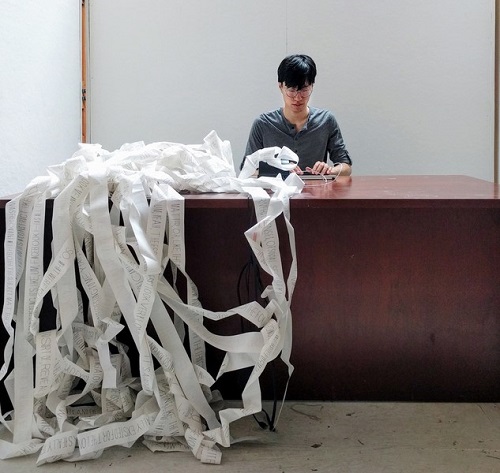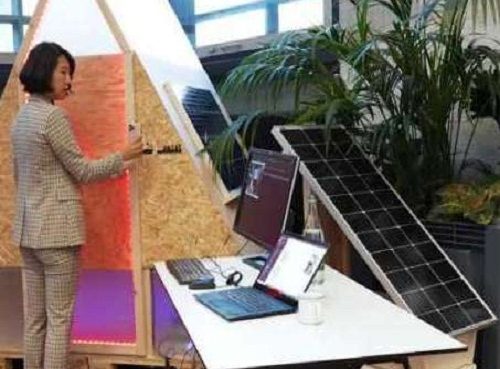The beauty of a nice infographic published alongside a news or magazine story is that it makes numeric data more accessible to the average reader. But for blind and visually impaired users, such graphics often have the opposite effect.
For visually impaired users — who frequently rely on screen-reading software that speaks words or numbers aloud as the user moves a cursor across the screen — a graphic may be nothing more than a few words of alt text, such as a chart’s title. For instance, a map of the United States displaying population rates by county might have alt text in the HTML that says simply, “A map of the United States with population rates by county.” The data has been buried in an image, making it entirely inaccessible.
“Charts have these various visual features that, as a [sighted] reader, you can shift your attention around, look at high-level patterns, look at individual data points, and you can do this on the fly,” says Jonathan Zong, a 2022 MIT Morningside Academy for Design (MAD) Fellow and PhD student in computer science, who points out that even when a graphic includes alt text that interprets the data, the visually impaired user must accept the findings as presented.
“If you’re [blind and] using a screen reader, the text description imposes a linear predefined reading order. So, you’re beholden to the decisions that the person who wrote the text made about what information was important to include.”
While some graphics do include data tables that a screen reader can read, it requires the user to remember all the data from each row and column as they move on to the next one. According to the National Federation of the Blind, Zong says, there are 7 million people living in the United States with visual disabilities, and nearly 97 percent of top-level pages on the internet are not accessible to screen readers. The problem, he points out, is an especially difficult one for blind researchers to get around. Some researchers with visual impairments rely on a sighted collaborator to read and help interpret graphics in peer-reviewed research.
Working with the Visualization Group at the Computer Science and Artificial Intelligence Lab (CSAIL) on a project led by Associate Professor Arvind Satyanarayan that includes Daniel Hajas, a blind researcher and innovation manager at the Global Disability Innovation Hub in England, Zong and others have written an open-source Javascript software program named Olli that solves this problem when it’s included on a website. Olli is able to go from big-picture analysis of a chart to the finest grain of detail to give the user the ability to select the degree of granularity that interests them.
“We want to design richer screen-reader experiences for visualization with a hierarchical structure, multiple ways to navigate, and descriptions at varying levels of granularity to provide self-guided, open-ended exploration for the user.”
Next steps with Olli are incorporating multi-sensory software to integrate text and visuals with sound, such as having a musical note that moves up or down the harmonic scale to indicate the direction of data on a linear graph, and possibly even developing tactile interpretations of data. Like most of the MAD Fellows, Zong integrates his science and engineering skills with design and art to create solutions to real-world problems affecting individuals. He’s been recognized for his work in both the visual arts and computer science. He holds undergraduate degrees in computer science and visual arts with a focus on graphic design from Princeton University, where his research was on the ethics of data collection.
“The throughline is the idea that design can help us make progress on really tough social and ethical questions,” Zong says, calling software for accessible data visualization an “intellectually rich area for design.” “We’re thinking about ways to translate charts and graphs into text descriptions that can get read aloud as speech, or thinking about other kinds of audio mappings to sonify data, and we’re even exploring some tactile methods to understand data,” he says.
“I get really excited about design when it’s a way to both create things that are useful to people in everyday life and also make progress on larger conversations about technology and society. I think working in accessibility is a great way to do that.”
Another problem at the intersection of technology and society is the ethics of taking user data from social media for large-scale studies without the users’ awareness. While working as a summer graduate research fellow at Cornell’s Citizens and Technology Lab, Zong helped create an open-source software called Bartleby that can be used in large anonymous data research studies. After researchers collect data, but before analysis, Bartleby would automatically send an email message to every user whose data was included, alert them to that fact and offer them the choice to review the resulting data table and opt out of the study. Bartleby was honored in the student category of Fast Company’s Innovation by Design Awards for 2022. In November the same year, Forbes magazine named Jonathan Zong in its Forbes 30 Under 30 in Science 2023 list for his work in data visualization accessibility.
The underlying theme to all Zong’s work is the exploration of autonomy and agency, even in his artwork, which is heavily inclusive of text and semiotic play. In “Public Display,” he created a handmade digital display font by erasing parts of celebrity faces that were taken from a facial recognition dataset. The piece was exhibited in 2020 in MIT’s Wiesner Gallery, and received the third-place prize in the MIT Schnitzer Prize in the Visual Arts that year. The work deals not only with the neurological aspects of distinguishing faces from typefaces, but also with the implications for erasing individuals’ identities through the practice of using facial recognition programs that often target individuals in communities of color in unfair ways. Another of his works, “Biometric Sans,” a typography system that stretches letters based on a person’s typing speed, will be included in a show at the Harvard Science Center sometime next fall.
“MAD, particularly the large events MAD jointly hosted, played a really important function in showing the rest of MIT that this is the kind of work we value. This is what design can look like and is capable of doing. I think it all contributes to that culture shift where this kind of interdisciplinary work can be valued, recognized, and serve the public.
“There are shared ideas around embodiment and representation that tie these different pursuits together for me,” Zong says. “In the ethics work, and the art on surveillance, I’m thinking about whether data collectors are representing people the way they want to be seen through data. And similarly, the accessibility work is about whether we can make systems that are flexible to the way people want to use them.”
Source: MIT










